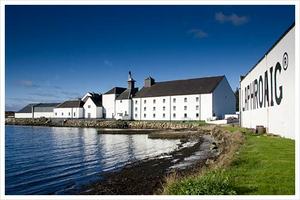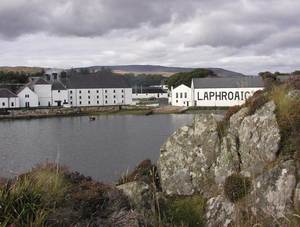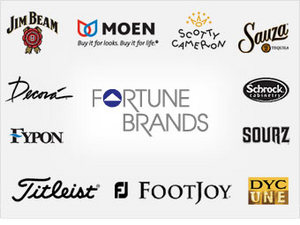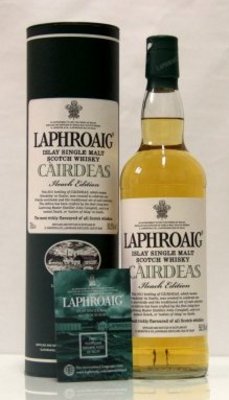|
|
Release Notes
Things are starting to change -- however slightly -- for Laphroaig, with the release of Cairdeas (pronounced "CAR-chess") Ileach Edition, a limited edition annual release that was formerly available only to Laphroaig's "Friends & Family" members -- and even then mostly only in Europe.
Cairdeas is a departure for Laphroaig in a lot of ways. It carries no age statement, is bottled at 101 proof, and it comes in a clear bottle instead of Laphroaig's traditional green ones. Cairdeas means "friendship" in Gaelic, and you'll likely need a friend in high places to find a bottle of this: Only 3,750 bottles are being produced for the U.S. (it will be sold in just eight states), and at just $60 retail, they are likely to go fast.
Drinkhacker.com
3rd Party Tasting Notes
The malt is a real winner: Eight years old, according to Campbell, and light as a feather in color. There's peat on the nose, reminding you this is Laphroaig at heart, but it's not aggressively smoky, coming across more as a damp mossiness than a trip up the chimney. On the tongue, the peat all but vanishes, revealing floral notes, lots of orange (almost candied), and a sweet, nougat-laden, and warming finish. Peat makes a comeback for the finale, leaving a rumbling, charcoal aftertaste. Amazing balance and perfect on a super wet day
Drinkhacker.com
Nose: Heavy alcohol first fading into sharp, sweet peat. Floral bouquets and sugar cane.
Palate: At first a smooth yet mysterious bitey peat puts the primer coat on the palate. It's letting me know this multi-layered bottle of sweetness is settling in and going to stay awhile. Once adjusted after a few sips, the whisky continues to roll in like the glimmering Islay sea. Vibrant splashes of caramel, vanilla, and peat meet lightly burnt seaweed, charcoal, and bourbon mash. Adding a splash of water helps soften the whisky, blending the flavors nicely together. Also, helps bring down the spice level a couple of notches.
Finish: Medium-heavy thickness, with water a medium that begins to resemble the standard 10 yr feel (uncut). Importantly, this is where the Makers Mark bourbon taste really shines, and part of the reason I appreciate this one more with each tasty dram! For each sip the final curtain finishes like a glass of Makers with a lasting shot of spicy, burnt peat.
Final Thoughts: Stays true to the signature Laphroaig combo of huge peat with an enticing sweetness while adding in significant notes from Makers Mark. I would say similar (but undoubtedly inferior!) results might be achieved by blending Laphroig Cask Strength/Makers Mark at 70/30, respectively. It's exciting to see a new addition to the Laphroaig family (if only a summer vacation in a few states). In the end, stays true for fans of Laphroaig and especially rewarding if you have the occasional taste for bourbon. Above average value for the price.
Palate: At first a smooth yet mysterious bitey peat puts the primer coat on the palate. It's letting me know this multi-layered bottle of sweetness is settling in and going to stay awhile. Once adjusted after a few sips, the whisky continues to roll in like the glimmering Islay sea. Vibrant splashes of caramel, vanilla, and peat meet lightly burnt seaweed, charcoal, and bourbon mash. Adding a splash of water helps soften the whisky, blending the flavors nicely together. Also, helps bring down the spice level a couple of notches.
Finish: Medium-heavy thickness, with water a medium that begins to resemble the standard 10 yr feel (uncut). Importantly, this is where the Makers Mark bourbon taste really shines, and part of the reason I appreciate this one more with each tasty dram! For each sip the final curtain finishes like a glass of Makers with a lasting shot of spicy, burnt peat.
Final Thoughts: Stays true to the signature Laphroaig combo of huge peat with an enticing sweetness while adding in significant notes from Makers Mark. I would say similar (but undoubtedly inferior!) results might be achieved by blending Laphroig Cask Strength/Makers Mark at 70/30, respectively. It's exciting to see a new addition to the Laphroaig family (if only a summer vacation in a few states). In the end, stays true for fans of Laphroaig and especially rewarding if you have the occasional taste for bourbon. Above average value for the price.
DramOfScotch.com
Pale colour. Young fresh malted barley and organic peat nose. Feels very young and shows grassy, sea weed maritime nose. An 'in your face' style but nicely balanced. Round intense palate, on the opposite of the nose. It feels matured in smaller casks, but apparently this is only Bourbon classic casks. Very close to the 10yo cask strength in style, with perhaps less fruit flavor and intensity. An overall nice dram. Maybe a bit more age next time! 86 points
WhiskyFun.com
The Distillery: Laphroaig
| Established: 1815 |
| Silent since: False |
| Address: Port Ellen, Isle of Islay, Argyll, PA42 7DU, UK |
| → website |
In the new Millenium
The Laphroaig distillery is arguably the most famous distillery on Islay. The island itself is famous for its pungent, peaty malts, so I guess that sort of makes the Laphroaig single malt the most famous peaty whisky. Laphroaig wasn"t my first peated malt whisky experience, but if I"m not mistaken it was the first other " peat monster" I tried after my discovery of the Lagavulin 16yo in 1991 - and I liked it a lot!
As far as I know the book is the first of its kind; a detailed history of a specific Scotch whisky distillery that was NOT written by their PR people. Well, those can have their own quirky charm as well I suppose; I still cherish the autographed copy of "The Definitive Guide To Buying Vintage Macallan" that Indian maniac Krishna gave me. I admire the boldness of charging £10,- for what"s basically a brochure for expensive bottlings (keeps the riff-raff from reading it, I suppose), but some of the proudly featured "antiques" later turned out to be fakes. A talented faker had convinced the PR people of Macallan to buy these bottles for their own archives...
But I"m getting side-tracked... The topic was Laphroaig distillery. I visited the distillery with some other maniacs during "Feis Ile 2005". The Islay Festival is great way to know the distilleries, the island and its inhabitants - which included quite a few swans and seals when we were there in May 2005. Every distillery on the island releases one or more " festival bottlings" each year, and those from Laphroaig are usually excellent - and relatively affordable too...

Ian Hunter had no descendants, so he left the distillery to his secretary, Elisabeth ("Bessie") Williamson. Bessie was the first female distillery manager on Islay (and quite probably in all Scotland); she managed Laphroaig until her retirement in 1972.
These were just a few small tidbits of information from the rich and diverse history of the Laphroaig distillery. Dutch writers Marcel van Gils and Hans Offringa have published a great book about it; The Legend of Laphroaig. The massive book (ISBN 9789089100276, published in 2007) is a must-have for all true Laphroaig fanatics. If you"re interested, you can order it via the official Laphroaig website (see above) or through Marcel van Gils" on-line shrine that"s at www.laphroaigcollector.com. The book is beautifully illustrated!
Laphroaig was "officially" founded in 1815 but rumour has it that the brothers Alexander and Donald Johnston actually built it around 1810 when they started farming in the area. The first official registration of the distillery wasn"t until 1826. The distillery remained in the Johnston family until 1954 when Ian Hunter left it to one Bessie Williamson.
I"ll get back to Bessie in a moment - there"s another little nugget of history I"d like to share with you first. The Johnston family provides a link between Laphroaig and another distillery on Islay: Tallant. It is long gone now (according to my copy of the "Moss & Hume" bible it was closed in 1852), but it was owned by another branch of the Johnston family tree. In those days, people still married their nephews and nieces (if they liked them enough), so after a marriage Laphroaig and Tallant were owned by the same family for a while. Unlike the name suggests, Ian William Hunter was a member of the Johnston family as well. He started working at Laphroaig in 1908 and remained there until his death in 1954.

And that"s the "general information" on the Laphroaig distillery so far... There"s a lot more to tell about Laphroaig, but the available space on this page is limited. So, I kindly refer you to the book "The Legend of Laphroaig" (by Marcel van Gils & Hans Offringa) for much more information about the history of the Laphroaig distillery. The "trivia" below are just a few tips of the iceberg - and the very top part of the tips at that...
As far as the bottlings are concerned; you can find my tasting notes on a few recent expressions at the bottom of this page. Generally speaking, I like recent official bottlings slightly less than I used to, simply because the value has decreased a little. At the end of the 1990"s many young "antiques" that had been bottled before, say, 1980 were more expensive than their siplings that were distilled in that year and bottled in their twenties. It"s safe to say that this situation has now changed...
2002 - Ian Henderson (who started his career at Laphroaig in 1989) retires as distillery manager.
2004 - The first edition of the Laphroaig "Quarter Cask" is launched. The whisky has no age statement, but it"s supposedly a vatting of "quarter casks" that have matured for circa five years. The contents of these casks is a little over 100 litres, so the wood-to-whisky ratio is much higher than in regular casks. This affects maturation.
2005 - The Laphroaig distillery is acquired by Fortune Brands, a subsidiary of Beam Global Spirits & Wine.
Trivia:
- Most distilleries have an even number of stills; x sets of a wash still and a spirit still. However, Laphroaig has an uneven number of stills - seven to be exact. In 1968 the number of stills was expanded from four to six and when Bessie Williamson retired in 1972 a seventh still was added - an extra spirit still.
- Laphroaig stands on the "grave" of another distillery in the Kildalton area of Islay. Unlike the aforementioned Tallant distillery, the Ardenistle distillery (a.k.a. Ardenestiel or Aredenistiel) was located right next to Laphroaig. It was founded in 1837 by Andrew & James Stein - but it was discontinued again just a decade later, around 1848. The remains are now part of the Laphroaig distillery.
- Laphroaig has been the only whisky to carry the Royal Warrant of the Prince of Wales (the 15-year-old is reportedly his favourite scotch whisky), which was awarded in person during a visit to the distillery in 1994.
from Malt Maniacs
The Owner: Fortune Brands
| Established: 1890 |
| Silent since: False |
| Address: Fortune Brands, Inc., 520 Lake Cook Road, Deerfield, IL 60015 |
| → website |
By the late 1990s, Fortune was rather different from what it had been ten years earlier. After getting rid of its tobacco holdings, Fortune began buying up companies in the home and office products area, such as Schrock Cabinet Co. and Apollo Presentation Products, a maker of overhead projectors. It also bought in the liquor segment, picking up Geyser Peak Winery in 1998 and entering an agreement in 1999 with two European liquor companies to jointly distribute their spirits worldwide. Fortune also vowed to better manage the brands in its portfolio, and in 1999 took a charge of $1.2 billion to restructure and write down goodwill. The company also announced it would cut costs by reducing its corporate staff by one-third and moving its headquarters to Lincolnshire, Illinois, where its office products division already was located.
From the complex dissolution of American Tobacco, designed and overseen by James Duke himself, came the elements of the modern tobacco industry. Spun off as new corporate entities were Liggett & Meyers, Lorillard, R.J. Reynolds, and a new, smaller American Tobacco Company. With the exception of Reynolds, these companies were given assets in all phases of the tobacco business, and Reynolds, the youngest and most aggressive of the companies, soon acquired what it lacked. Control of British-American Tobacco was lost to the British, where it has remained. Duke turned over direction of American Tobacco to Percival S. Hill, one of his veteran lieutenants, and himself went with British-American as chairman and one of its directors. The founder retained large holdings of stock in each of the newly formed spin-offs and, upon his death, left a great deal of money to the eponymous Duke University and a score of other charitable causes.
The immediate postwar years were good for American Tobacco, which upped its overall share of the domestic tobacco market to 32.6 percent in 1953. However, that would prove to be the high-water mark for the company"s cigarette business. In the long run, however, American Tobacco"s relative failure in cigarettes may have been a blessing. Beginning in the mid-1960s, the company used the steady cash flow from its remaining tobacco business to make a number of promising acquisitions. Chief among these were Gallagher Ltd., one of the United Kingdom"s largest tobacco companies; James B. Beam Distilling Company; Sunshine Biscuits; Duffy-Mott; and several makers of office products. In recognition of the company"s changing profile, it was renamed American Brands in 1969, by which date its share of the domestic tobacco market had slipped to 20 percent and continued to decline. After a handful of other minor acquisitions, American Brands made its largest purchase in 1979, buying The Franklin Life Insurance Company, the tenth largest life insurer in the United States. By that time, non-tobacco assets were generating one-third of American Brands" operating income of $364 million, and the company"s diversification program generally was regarded as a modest success.
Duke"s control of United Cigar Stores" more than 500 outlets gave the public a clearer picture of the extent of Duke"s domain, and his company soon faced rising criticism and opposition, some of it violent. Those in both the industry and the public had reason to dislike Duke and his cartel; Kentucky tobacco growers, for example, their prices repeatedly lowered by the single large buyer in town, banded together in 1906 to burn down a number of the trust"s large tobacco warehouses. More serious was the increasing pressure brought to bear by the U.S. Department of Justice, which took heart under the administration of President Theodore Roosevelt and began a series of antitrust actions against the industrial combines. In 1907, the department filed suit against Duke"s creation, now once again called American Tobacco Company, and in 1911 the Supreme Court agreed that the trust must be dissolved to restore competition to the tobacco industry. Total corporate assets were estimated at more than $500 million.
Fortune Brands traces its origin to the remarkable career of James Buchanan (Buck) Duke, founder of The American Tobacco Company. Duke was born in 1856 on a small farm outside Durham, North Carolina, where his father, Washington Duke, raised crops and livestock. The Duke farm was ravaged by armies of both North and South at the end of the Civil War, and upon his release from a military prison Washington Duke found that his sole remaining asset was a small barn full of bright leaf tobacco. Bright leaf, so called because of its golden color, had been introduced only recently, but its smooth smoking characteristics were already making it a favorite, and its fame was soon spread by the returning war veterans. Duke set out to peddle what leaf he had, and, pleased with the response, he quickly converted his land to tobacco culture, selling his wares under the name Pro Bono Publico, meaning "for the public good" in Latin. In its first year of operation, W. Duke & Sons sold 15,000 pounds of tobacco and netted a very handsome $5,000.

Duke had grown to dominance of the cigarette business in a single decade and, shortly, was to duplicate the feat worldwide. Though triumphant, Duke was faced with the prospect of continuing bitter competition and restricted profits. The 32-year-old veteran thereupon proposed a solution that was startling in scope: to merge all five of the competitors and, by joining forces, bring to an end the wasteful price warfare. His fellow manufacturers at first balked at the initiative, but they eventually agreed and in January 1890 formed The American Tobacco Company, its $25 million in capital divided among ten incorporators, with J.B. Duke named president. The new company, one of the first true combinations in the history of U.S. business, controlled 80 percent of the nation"s cigarette business and showed a net profit of $3 million in its first year.
Fortune Brands, Inc., is a widely diversified conglomerate with principal businesses in distilled spirits, home products, hardware, office supplies, and golf equipment. Most of its brands are either number one or number two in their market categories. Fortune"s brands include Jim Beam, the world"s best-selling bourbon, Swingline staplers, Acco paper clips, Master Lock padlocks, Moen faucets, and Titleist and Pinnacle golf balls. Fortune was a major player in the tobacco industry until the late 1990s, when it sold its domestic and foreign tobacco interests and got out of that business entirely. Nearly 20 of the company"s brands generate more than $100 million in sales.
In 1991, American Brands strengthened its hold on the distilled spirits market by acquiring seven brands from the Seagram Company. American spent $372.5 million for the brands, which represented approximately one-quarter of giant Seagram"s sales in the United States. In the midst of a turndown in liquor consumption, Seagram had decided that those who were drinking less should drink better. Thus, it wanted to unload some of its less prestigious brands. American, however, was deliberately pursuing the opposite tack, aiming for more budget-conscious consumers. The brands it took over from Seagram were the American whiskies Calvert Extra and Kessler, Canadian whisky Lord Calvert, Calvert gin, Ronrico rum, Wolfschmidt vodka, and Leroux liquor. The acquisition made American"s subsidiary Jim Beam Brand Company the third largest spirits company in the United States. American"s strategy seemed profitable. Though its new liquor brands and its tobacco brands lacked both snob appeal and great market share, they did make money. Profits rose to record levels in 1991, with a rise of almost 40 percent for the year. Liquor sales, bucked by the Seagram acquisition, rose 12 percent, and tobacco sales rose all of 1 percent. This small rise, however, was the first increase for American since 1965.
The company then changed its name in 1996, from American Brands to Fortune Brands. This came after the company sold the last vestige of its tobacco business, its British unit, Gallagher. The company was concerned that investors still associated its old name with a tobacco company. For example, when a smoker in Florida won a substantial jury award against another tobacco company in August 1995, American"s stock suffered. The newly named company"s CEO, Thomas Hays, explained the rationale behind the choice, saying, "People talk a lot about something being fortunate or making a fortune, which is certainly what we want to do for our shareholders" (from a December 9, 1996 interview in Fortune magazine).
from FundingUniverse.com
